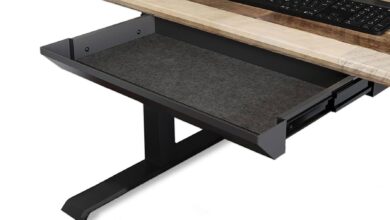Finding the Perfect Office Chair for Back Pain Relief
Dealing with back pain at your desk? Finding the perfect office chair can be a game-changer. This guide explores the best options designed to alleviate aches and pains, promoting comfort and support throughout the workday. We’ve considered factors like lumbar support, adjustable features, and overall ergonomics to bring you chairs that prioritize your back health without sacrificing style or practicality.
Contents
- 1 Understanding Your Back Pain and Choosing the Right Chair
- 2 Identifying Your Specific Needs: What Ails Your Back?
- 3 The Crucial Role of Lumbar Support: The Key to Comfort
- 4 Adjustable Height: A Crucial Factor for Comfort and Ergonomics
- 5 Armrests: Essential for Posture and Relieving Strain
- 6 Seat Depth: Finding the Perfect Fit for Your Body
- 7 Material and Comfort: Choosing a Quality Cushion
- 8 Wheel Design: Smooth Movement and Support
- 9 Durability and Build Quality: Investing in Long-Term Comfort
- 10 Warranty and Customer Service: Peace of Mind During Use
- 11 Understanding Your Back Pain and How a Chair Can Help
- 12 Assessing Your Needs: Beyond Just a “Comfortable” Chair
- 13 Lumbar Support: The Key to Spinal Alignment
- 14 Adjustability: Tailor-Made Support for Your Body
- 15 Seat Depth and Width: Promoting Ergonomics
- 16 Armrest Functionality: Minimizing Strain on Shoulders and Neck
- 17 Material and Durability: Investing in Long-Term Support
- 18 Footrest and Heel Support: Addressing Lower Body Strain
- 19 Warranty and Reviews: Understanding the Value
- 20 Considering the Overall Design: Finding the Perfect Fit
- 21 Ergonomic Features to Look For: More Than Just a Pretty Face
- 22 Lumbar Support: The Unsung Hero of Back Health
- 23 Seat Depth and Width: Finding Your Perfect Fit
- 24 Adjustability: A Must-Have for Individual Comfort
- 25 Armrests: Essential for Reducing Strain on Shoulders and Neck
- 26 Finding Your Perfect Ergonomic Seat
Understanding Your Back Pain and Choosing the Right Chair
Back pain is a common complaint, especially in the office environment. Many factors contribute to it, from poor posture to the wrong ergonomic setup. If you’re struggling with back pain while working, choosing the right office chair can make a huge difference. It’s not just about finding a comfy chair; it’s about finding one that actively supports your back and promotes good posture throughout the day. This involves considering specific needs like lumbar support, adjustable features, and even the overall design of the chair. Ultimately, the "best" chair is the one that fits your particular body type and work style, alleviating discomfort and promoting a healthy posture. Don’t just settle for any old chair – invest in a chair that prioritizes your well-being.
Identifying Your Specific Needs: What Ails Your Back?
Before diving into chair features, understanding the root of your back pain can significantly impact your choice. Are you experiencing lower back pain, stiffness in your neck, or maybe even general discomfort? Consider the activities you perform at your desk. Do you spend hours hunched over your keyboard? Do you frequently shift positions or lean back in your chair? Identifying the specific areas where you experience pain helps to narrow down the features of the ideal office chair. A chair that excels at lumbar support might not be the best solution if you’re constantly experiencing neck strain. The key is to pinpoint the factors contributing to your discomfort and look for a chair that directly addresses them. This may require experimentation to find the perfect fit and support system for your body. This initial assessment should include considering your height, weight, and the overall amount of time you spend seated.
The Crucial Role of Lumbar Support: The Key to Comfort
Lumbar support is often cited as one of the most important features in an office chair for back pain sufferers. The lumbar region of your spine is especially prone to strain from prolonged sitting, and effective support can significantly reduce this pain. Look for chairs with adjustable lumbar support – a feature that allows you to customize the support to perfectly fit the natural curve of your lower back. This precise support prevents slouching and encourages a healthy posture. You might even need to experiment with different types of lumbar support, such as those that use a contoured design or adjustable height. A well-designed lumbar support system will not only alleviate pain but also help maintain correct posture, which is vital for overall well-being. Imagine the chair as your personal back brace during long working hours; proper support is fundamental.
Adjustable Height: A Crucial Factor for Comfort and Ergonomics
Adjustable height is a fundamental feature for any office chair, especially if you’re aiming to combat back pain. It allows you to perfectly adjust the chair’s height to match your desk’s height, ensuring that your feet are flat on the floor and your hips and knees are at a 90-degree angle. This ergonomic setup is crucial for avoiding strain on your back and legs. A chair with a fixed height might feel uncomfortable, and this can be a significant contributor to back pain over time. Poor alignment can quickly lead to muscle strain and discomfort, negatively impacting your posture and productivity. This fundamental adjustment is essential for both comfort and ergonomics, ensuring a healthier and more productive work experience.
Armrests: Essential for Posture and Relieving Strain
Armrests, often overlooked, can play a significant role in preventing back pain. Properly positioned armrests provide support for your arms and shoulders, reducing the stress on your neck and upper back. An ideal chair has adjustable armrests that can be moved closer or further apart to match your preferred sitting position. This adjustable functionality is key, as different individuals have different arm positions and needs. Imagine sitting at your desk all day without arm support; the strain on your upper body could accumulate quickly, potentially leading to chronic pain. Armrests offer crucial support in maintaining a good posture, which further minimizes discomfort and pain.
Seat Depth: Finding the Perfect Fit for Your Body
Seat depth is another crucial element of a good office chair for back pain. A chair with an appropriately sized seat prevents you from sliding forward or backward while sitting. Too little depth can place strain on your lower back, while too much depth might make you feel unsupported. Look for chairs that allow you to adjust the seat depth to accommodate your body shape and prevent discomfort. This subtle aspect directly impacts your posture and can significantly impact back health. Consider a seat cushion that adjusts to the individual’s shape and seating position for an additional layer of comfort. Proper depth prevents you from hunching forward, directly contributing to long-term back health.
Material and Comfort: Choosing a Quality Cushion
The material of an office chair is a big factor, particularly for the seat cushion. A supportive and breathable material is preferable for all-day comfort. Look for chairs with high-quality padding that provides a comfortable and supportive feel. A well-padded seat can significantly reduce pressure points and minimize discomfort. This comfort feature is essential, especially if you’re spending a considerable portion of your day seated. High-quality cushioning promotes proper blood circulation, further preventing issues that may contribute to back pain. A soft yet supportive cushion makes the difference between an enjoyable and painful work session.
Wheel Design: Smooth Movement and Support
The design of the wheels can impact the comfort and support a chair provides. Look for chairs with smooth-rolling wheels that provide a comfortable experience for moving around in your workspace. Consider the surface of your office. Hard floors will require durable wheels, while carpets will benefit from softer options. These details are often overlooked, yet they contribute to the overall comfort and ease of movement while seated. Smooth rolling wheels not only reduce friction but also ensure stability. An office chair that glides easily around your workspace is less likely to cause strain on your body and back.
Durability and Build Quality: Investing in Long-Term Comfort
A chair’s durability and build quality are crucial for preventing back pain in the long run. A well-built chair is less likely to break down after prolonged use. Look for high-quality materials and sturdy construction to ensure the chair can stand up to daily wear and tear. An inexpensive chair that breaks down quickly will not only be less comfortable but can also increase the risk of injury over time. Investing in a durable chair is a sensible investment, ensuring a comfortable and supportive work environment for years to come. Durability is a significant factor that ensures the chair stands up to the test of time.
Warranty and Customer Service: Peace of Mind During Use
Finally, consider the warranty and customer service offered by the chair manufacturer. A chair with a solid warranty can give you peace of mind, knowing you have recourse if the chair develops problems. Quick customer support can ensure issues are promptly addressed, enhancing your comfort throughout the chair’s lifetime. A chair with excellent customer service is a valuable asset during the product’s lifespan; it means less stress should something go wrong. This aspect contributes to the value proposition of your office chair investment.
Understanding Your Back Pain and How a Chair Can Help
Back pain, that familiar ache or stiffness, is a common complaint, affecting people of all ages and activity levels. It can range from a mild twinge to a debilitating throbbing, disrupting work, sleep, and daily life. Understanding the root causes of your back pain can significantly inform your choice of office chair. Is it muscle strain from prolonged sitting? Perhaps poor posture is the culprit, or could it be a pre-existing condition exacerbated by the wrong chair? If you’re experiencing consistent back pain while working, chances are your current setup isn’t supporting your spine correctly. A properly designed office chair can play a crucial role in alleviating these issues and promoting better posture. It can become your best friend in the fight against back pain, acting as a supportive and comfortable partner in your workday. Think of it as a preventative measure, helping to maintain spinal health and avoid future pain.
Assessing Your Needs: Beyond Just a “Comfortable” Chair
Choosing the “best” office chair isn’t solely about comfort; it’s about aligning the chair’s features with your specific needs and back pain triggers. Do you spend hours hunched over a computer, or are you a frequent traveller with a more dynamic work style? Do you have any pre-existing back conditions, or injuries that require special support? Consider your body type, your typical workday posture, and any pre-existing medical conditions. This is where detailed research and potentially consulting a physical therapist can be incredibly valuable. A chair that might be perfect for someone with a sedentary job might not suit someone who needs to shift positions frequently. Consider factors like lumbar support, adjustable height and armrests, and the chair’s overall build. Don’t just focus on plush cushions; consider the functionality and ergonomics of the chair. Understanding your unique circumstances will ensure you choose a chair that genuinely addresses your needs and potentially reduces pain.
Lumbar Support: The Key to Spinal Alignment
Lumbar support is often the most critical feature in an office chair designed for back pain relief. It’s essentially a cushion or contoured piece of the chair designed to cradle the natural curve of your lower back. A good lumbar support system helps maintain the spine’s natural S-shape, distributing weight evenly and preventing the spine from slumping. Imagine a properly supported spine as a well-maintained highway. It allows for smooth and easy movement without any dangerous curves or strain points. Look for adjustable lumbar supports that allow you to customize the firmness and height to perfectly match your back’s needs. A chair without proper lumbar support can lead to chronic muscle strain, which can eventually manifest into back pain. Choosing a chair with a supportive lumbar design is a significant step toward long-term spinal health.
Adjustability: Tailor-Made Support for Your Body
An adjustable office chair offers the crucial ability to perfectly fit your body and work style. The ability to adjust the height, seat depth, and armrest position makes all the difference in promoting proper posture. This customizability empowers you to establish a supportive position that aligns with your unique body proportions. Imagine trying to drive a car without being able to adjust the seat. It would be uncomfortable and possibly dangerous. Similarly, a chair that can’t adjust to your needs won’t provide the correct support for a healthy back. Invest in adjustable features to create a personalized workspace that promotes optimal spinal health and minimizes the risk of back pain.
Seat Depth and Width: Promoting Ergonomics
The seat depth and width of your office chair directly affect your posture. An appropriately sized seat allows your back to naturally rest against the chair’s support structures. A seat that is too shallow can lead to your back arching away from the chair’s support, and a seat that is too deep can force your knees too far forward. If you’re prone to back pain, your chair should facilitate a healthy sitting position. Think about your knees; they should ideally be at or just below a 90-degree angle when seated. If your legs dangle or your knees are angled upwards, your posture is compromised. A wider seat provides better overall support and can prevent issues with pressure points. A chair that accurately fits your body will promote better circulation and overall comfort.
Armrest Functionality: Minimizing Strain on Shoulders and Neck
Armrests are often overlooked but can significantly impact back health. Adequate arm support prevents your shoulders from hunching forward, which in turn protects your neck and upper back. Armrests should support your elbows at a 90-degree angle when your hands rest on them. When you don’t have proper support, your shoulders tense up. Over time, this can lead to pain, stiffness, and even more severe back issues. Look for adjustable armrests that offer the flexibility to position your arms in a comfortable and supportive manner. With armrests positioned correctly, you reduce stress on your shoulders and neck, directly minimizing strain on the rest of your spine.
Material and Durability: Investing in Long-Term Support
The material of your office chair greatly impacts its comfort and durability. Look for materials that offer proper breathability, support, and long-term use. A sturdy frame ensures the chair can handle daily use and maintain its shape over time. Think of the chair as a long-term investment, similar to a good pair of shoes; you want something durable and comfortable. Cheap materials might seem appealing initially, but they can wear out quickly, resulting in poor posture and chronic pain. The quality of the material is vital in your selection.
Footrest and Heel Support: Addressing Lower Body Strain
A footrest can be invaluable for improving posture and comfort, especially for those with lower back pain. It keeps your feet supported and improves circulation in your legs and feet. Poor lower body support frequently leads to slouching, which impacts posture in your upper body. Proper positioning of your lower body can directly influence your posture. A footrest can also prevent fatigue, which can contribute to posture problems. Many chairs often overlook this crucial aspect of overall ergonomic support. A good footrest allows your feet to remain flat and supported, enhancing overall body alignment.
Warranty and Reviews: Understanding the Value
A good warranty signals the manufacturer’s confidence in the chair’s quality and durability. A longer warranty period often signifies the chair’s robust construction. Thorough reviews from other users can provide invaluable insights. Look for feedback from people with similar needs or back conditions. Real-world experiences can reveal whether the chair provides the support and comfort you need. Reading reviews and investigating warranty options ensures you’re not just purchasing a chair but investing in a solution to a potentially recurring problem. Check the manufacturer’s return policy as well.
Considering the Overall Design: Finding the Perfect Fit
Finally, consider the overall design of the chair. A well-designed chair is not just functional but also aesthetically pleasing. It shouldn’t be just about the support; it should be about enhancing your work experience. Look for a chair that fits your personal style. Whether you prefer a sleek modern design or a more classic look, there’s an office chair that blends function and aesthetics. A comfortable and visually appealing environment can reduce stress and improve your focus and overall productivity. This factor should not be overlooked when searching for the best office chair for back pain.
Ergonomic Features to Look For: More Than Just a Pretty Face
Choosing a chair for back pain relief isn’t just about aesthetics. It’s about investing in a tool that actively supports your posture and minimizes strain. This means paying attention to the chair’s ergonomic features. These aren’t just fancy buzzwords; they’re the building blocks of a healthy, pain-free workday. Forget about that uncomfortable chair you’ve been putting up with – finding the right ergonomic features can make a huge difference in your comfort and well-being. Look for chairs that offer adjustable components that adapt to your unique body shape and preferences, rather than a one-size-fits-all approach. This will drastically improve your comfort and likely reduce the chances of experiencing pain or discomfort. Remember, a supportive chair should feel like a comfortable hug for your back, rather than a rigid constraint.
Lumbar Support: The Unsung Hero of Back Health
Lumbar support is arguably the most crucial ergonomic feature for preventing and relieving back pain. This area of your back, located just below your rib cage, is particularly vulnerable to strain and pressure. A good lumbar support system is designed to cradle this curve, keeping your spine aligned in its natural S-shape. Imagine a perfect, supportive hug for your lower back. This crucial support prevents slouching, promoting proper posture and reducing pressure on the discs and ligaments in the lumbar region. Look for adjustable lumbar support that conforms to the natural curve of your back; this customization is key for optimal comfort. A well-designed lumbar support should provide a gentle, firm embrace, not a harsh, rigid block. Ultimately, the goal is to maintain the correct spinal alignment throughout the workday. Lack of proper lumbar support is a significant contributor to back pain, so prioritizing it is crucial. A chair with flexible, adjustable lumbar support can mean the difference between a comfortable day and a painful one.
Seat Depth and Width: Finding Your Perfect Fit
The seat depth and width of your office chair are critical for proper spinal alignment. If the chair is too deep, your knees might end up being bent at an unnatural angle, putting strain on your lower back. Similarly, a too-shallow seat won’t provide sufficient support for your thighs and hips. You want the seat to cradle your sit bones (ischial tuberosities), supporting your weight evenly and comfortably.
| Seat Depth Issues | Impact on Back Health |
|---|---|
| Too Deep | Increased pressure on lower back, potential for slouching. |
| Too Shallow | Lack of support for thighs and hips, potential for discomfort and uneven weight distribution. |
Finding the perfect fit involves sitting in the chair and checking how your legs are positioned. Your knees should be at or just below a 90-degree angle when your feet are flat on the floor. Similarly, a properly sized seat width prevents pressure points and discomfort. The width should properly accommodate your hips and glutes, ensuring balanced weight distribution. Think of your chair’s seat as a tailor-made seat for your posterior; it should fit you snugly, but without feeling constricting. If you need it, consider seat cushions for extra padding and support. Measuring your body dimensions and researching the seat depth and width of different chairs before purchase is a great way to ensure the chair is right for you.
Adjustability: A Must-Have for Individual Comfort
A truly great office chair offers a wide range of adjustability. This isn’t just about height; it’s about customization. The ability to adjust the seat height, armrests, and lumbar support is critical for personal comfort. Consider how you sit and which parts of your body require the most support. If you tend to lean forward, adjustable lumbar support can help maintain your posture throughout the day, which could significantly reduce your risk of developing pain. Similarly, adjustability is critical for preventing discomfort in your hips, back, shoulders, neck, and arms.
A chair that allows you to customize the seat tilt and armrests ensures your entire body is comfortable and supported while working. It’s about tailoring your chair to your specific needs rather than forcing your body into a prescribed seating position. Adjustable armrests will prevent stress on your shoulders and arms, too. The ability to customize the armrest height and position ensures proper alignment and reduces strain on your neck and shoulders. Think of an adjustable chair as a personalized workstation – it’s designed to improve and fit your experience.
Armrests: Essential for Reducing Strain on Shoulders and Neck
Armrests are often overlooked, but they play a crucial role in minimizing strain on your shoulders and neck. Proper armrest height and position can dramatically reduce tension headaches and stiffness that may occur from poor posture. Ensure the armrests are high enough to support your forearms at a 90-degree angle when your elbows are bent. Too low, and you’ll be placing undue stress on your shoulders; too high, and you’ll likely push your elbows off the chair, which can cause discomfort and reduced support. When selecting armrests, consider their adjustability. Fixed armrests are less accommodating for various body types and positions. Adjustable armrests are preferred as they allow you to maintain a neutral posture, reduce fatigue, and support your body in its natural state, preventing pain. Choosing armrests is just as important as the other ergonomic features as they directly influence your overall posture.
Finding Your Perfect Ergonomic Seat
So there you have it – a guide to finding the best office chair for your back pain. Hopefully, you’ve found some helpful insights here. Choosing the right chair is a significant investment in your well-being, and hopefully, this article has helped you make an informed decision. Thanks for reading, and feel free to drop back by whenever you need more office inspiration or tips for a healthier workspace!









